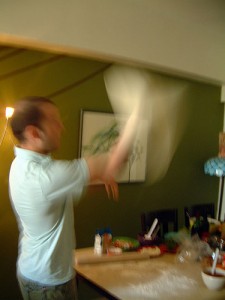Art of pizza tossing inspires micro motor design

Researchers at Monash University in Australia have unlocked the physics of the perfect pizza toss and will use it to design the next generation of standing wave ultrasonic motors (SWUMs), devices thinner than a human hair.
According to a news release, Mr Daniel (Kuang-Chen) Liu, a PhD student, Associate Professor James Friend, and Senior Lecturer Leslie Yeo, studied a video of professional chefs tossing dough and then calculated a way to best describe the dough’s trajectory--including how much it rotates, how quickly it spins, its stability and the energy efficiency of the toss itself.
The result is a set of nonlinear differential equations that, in addition to capturing the art of pizza tossing, could help the researchers design optimal standing wave ultrasonic motors (SWUMs), which operate on similar principles as pizza tossing.
Standing wave ultrasonic motors are electric motors with an ultrasonic vibrating stator (the stationary part of a rotor system), that causes the move-able part, the disc-like rotor, to be "tossed" – both rotated and lifted.
"In brief, if you toss a pizza dough one toss at a time – that is, if you toss then catch – your hands should move in a helical fashion, like they are moving along a spiral, a curved line laid along a cylinder," Associate Professor Friend said. "If you are tossing the pizza continuously, not stopping to catch it and stop every time, then your hands should move in circles."
Through investigation of the types of dough tossing, the researchers discovered the analogy that a disk of dough spins just like a motor's rotor because the chef tosses the rotor just like a motor does. Here's an excerpt from an abstract of a published paper that details the research, and elevates pizza tossing insight into science:
The system's dynamics explains why certain tossing motions are used by dough-toss performers for different tricks: a helical trajectory is used in single tosses because it maximizes energy efficiency and the dough's airborne rotational speed, a semi-elliptical motion is used in multiple tosses because it is easier for maintaining dough rotation at the maximum rotational speed. The system's bifurcation diagram and basins of attraction also informs SWUM designers about the optimal design for high speed and minimal sensitivity to perturbation.
These same scientists previously helped develop the world's smallest useful motor, only a quarter of a millimetre wide, that could potentially be used for minimally invasive neuro-microsurgery. "It could be used in the propulsion system of miniature machines to swim through the bloodstream to inaccessible places, potentially revolutionising future surgical procedures," states another press release.
